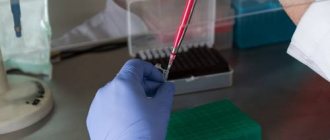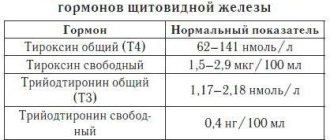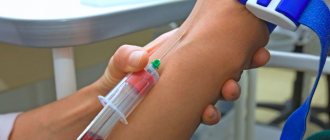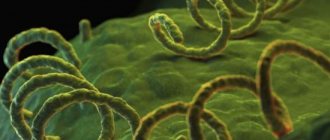Humanity realized the danger posed by the human immunodeficiency virus (HIV) too late.
The disease it causes is acquired immunodeficiency syndrome (AIDS).
True, at the beginning of the 21st century, doctors have learned to effectively fight this infection.
No one will deny that the leading role in this direction was played by the improvement of laboratory methods for detecting infection.
As well as studies of blood parameters of already infected people.
If the result is positive
A positive result means that the test system detected antibodies to HIV in the blood sample, which may indicate that you actually have HIV infection. A positive result in ELISA must be confirmed in an immunoblot with the same blood sample. In rare cases, the result is false positive. False-positive results occur with viral infections in pregnant women, and with autoimmune diseases. A positive result may also be referred to as seropositive or HIV+ status.
General blood test indicators for HIV
In the early stages of infection, the indicators of a general blood test change little or even remain within the normal range.
An attentive physician can associate some marginal fluctuations in leukocytes (white blood count) with episodes of repeated recurrent colds and respiratory infections.
In more advanced stages of the disease, when the body’s compensatory capabilities weaken, the following changes occur in the CBC:
- Anemia. A decrease in the number of red blood cells below the age and gender norm is associated with HIV damage to bone marrow cells and general exhaustion of the body. The degree of anemia correlates with the activity of HIV infection: anemia increases with the progression of the disease and, conversely, recedes during ART therapy.
- Leukopenia and lymphopenia are typical phenomena for HIV. A general blood test can detect a persistent decrease in the number of leukocytes (below 4*10 to the 9th degree) and lymphocytes (below 13%), the indicators of these cells help doctors make a preliminary prognosis and develop measures to protect a person from other infections (for example, prescribe biseptol prophylaxis ).
- Thrombocytopenia. A drop in platelet levels below normal (180*10 to the 9th power) is very typical for HIV infection; within 10 years, this phenomenon occurs in 45% of infected people. Thrombocytopenia is caused by two mechanisms: autoimmune damage to thrombocytopenia and a decrease in the number of their precursors (megakaryocytes).
It is very important for the patient to comply with the deadlines when the doctor recommends taking the OAC.
This will help you notice dangerous complications of HIV infection in time and prevent them.
In addition, we must not forget about the risk of developing adverse reactions in response to pre-drug ART therapy.
If the result is doubtful
Quite rarely, test results are questionable. This can happen in two cases: when a person has recently become infected with HIV and the concentration of antibodies is insufficient for detection by conventional test systems, or when HIV is absent, but there are other chronic diseases - metabolic or autoimmune in nature. Therefore, testing immediately after exposure is inappropriate. If a questionable result was obtained during examination using the enzyme immunoassay method, a confirmatory analysis is usually performed using an immunoblot. If the questionable result remains, the examination is repeated after 1-3 months and the patient is observed for six months.
ESR indicator
A very important data from the CBC is the erythrocyte sedimentation rate, or ESR for short.
The norm is 4-10 mm per hour.
When the ESR accelerates, this indicates an imbalance in the protein balance of the blood.
Unfortunately, the indicator is completely nonspecific: ESR increases with any infection, injury, or oncology.
Patients are characterized by such a combination when the erythrocyte sedimentation rate is increased to 30-40-50 mm per hour.
And the person feels more or less normal.
This picture is associated with a decrease in the number of white blood cells.
In particular, those lymphocytes that synthesize immunoglobulin proteins.
A decrease in the amount of these immune proteins entails a relative increase in albumin proteins, which is reflected in the increase in ESR.
What can be done to prevent HIV from developing into AIDS?
If a person is diagnosed with HIV infection, he needs to start antiretroviral therapy (ART) as soon as possible, which will suppress the replication of the virus. Those registered with the territorial Center for the Prevention and Control of AIDS are given the medicine free of charge. A doctor should select a treatment regimen and help you register. A person taking the medicine will never get AIDS and will be able to live a normal life, says the US Centers for Disease Control and Prevention (CDC) in a leaflet about HIV. However, the drug will not be able to completely cleanse the body of infection, so you will have to take it for the rest of your life.
– The goal of therapy is to achieve an undetectable viral load. This means that the virus is completely suppressed, but its inactive forms live in cells,” says Nikolai Lunchenkov, an infectious disease specialist at the H-Clinic University Clinic.
Popular questions and answers about HIV
How does HIV manifest in men and women?
The symptoms of HIV in women are exactly the same as the symptoms of HIV in men. Manifestations may differ only at the level of genitourinary diseases, when the body is already very weakened - for example, thrush appears more often in women. Otherwise, there are no specific signs by gender.
Is there a cure for HIV?
Technically, we can say that there is no cure for HIV - patients are constantly required to undergo special therapy. But the results that it allows to achieve make the patient a healthy person who can live calmly for decades without any problems - you just need to constantly take medications and monitor your health.
HIV has not been a fatal disease for a long time!
Is HIV a disease of drug addicts and people with disordered lifestyles?
In fact, this is a myth that HIV activists are constantly dispelling. Unfortunately, a person who leads a healthy lifestyle and is responsible for their relationships can also get this disease. It is enough that a sexual partner can cheat – and in this way “bring” illness to the couple. HIV is not always a sign of an irresponsible attitude towards one’s life.
Who are HIV dissidents?
These are people who, contrary to scientific data and common sense, deny the existence of the virus. They refuse treatment, which inevitably leads to early death. Such people are also dangerous because, due to lack of treatment, they spread the virus among their sexual partners without warning them of the possible danger (because they do not believe that it exists).
The success of HIV treatment and long life lies in seeking help and starting therapy as early as possible. In this case, a person will have a long life without fears and difficulties.
Preparation
The reliability and accuracy of the study indicators largely depend on the correct preparation of the patient for its conduct. When being tested for HIV, a patient must:
- take the test on an empty stomach; food intake must be stopped at least 4-5 hours before donating blood (otherwise changes in biochemical parameters may cause a false deviation from the norm);
- abstain from alcohol (3 days in advance), smoking (1 hour in advance);
- physical overload on the eve of the analysis should be limited.
HIV 1, 2 Ag/Ab Combo (determination of antibodies to HIV types 1 and 2 and p24 antigen)
Study of specific antibodies and p24 antigen of the human immunodeficiency virus.
Synonyms Russian
Antibodies to HIV 1, 2, antibodies to human immunodeficiency virus, HIV-1 p24, HIV-1 antigen, p24 antigen.
English synonyms
Anti-HIV, HIV antibodies, human immunodeficiency virus antibodies, HIV-1 p24, HIV-1 Ag, p24-antigen.
Research method
Electrochemiluminescent immunoassay (ECLIA).
What biomaterial can be used for research?
Venous blood.
How to properly prepare for research?
- Testing for HIV infection can be carried out anonymously and confidentially. During a confidential examination, it is mandatory to present a passport.
- Do not smoke for 30 minutes before the test.
General information about the study
HIV (human immunodeficiency virus) is a virus of the retrovirus family that infects cells of the human immune system (CD4, T helper cells). Causes AIDS.
HIV-1 is the most common type of virus, most often found in Russia, the USA, Europe, Japan and Australia (usually subtype B).
HIV-2 is a rare type, common in West Africa.
To diagnose the human immunodeficiency virus, a fourth-generation combined test system is used, which is capable of detecting HIV infection within 2 weeks after the virus enters the blood, while first-generation test systems do this only 6-12 weeks after infection.
The advantage of this combined HIV test is the detection, thanks to the use of antibodies to HIV-1 p24 as reagents, of the specific p24 antigen (viral capsid protein), which can be detected by this test within 1-4 weeks from the moment of infection, i.e. even before seroconversion, which significantly shortens the “window period”.
In addition, this HIV test detects antibodies to HIV-1 and HIV-2 in the blood (using the antigen-antibody reaction), which are produced in sufficient quantities to be detected by the test system 2-8 weeks after infection.
After seroconversion, antibodies begin to bind to the p24 antigen, resulting in a positive HIV antibody test and a negative p24 test. However, after some time, both antibodies and antigen will be detected in the blood at the same time. At the terminal stage, an AIDS test for antibodies to HIV may give a negative result, since the mechanism of antibody production is disrupted.
Stages of HIV infection
- The incubation period, or “seronegative window period,” is the time from the moment of infection until the development of protective antibodies to the virus in the blood, when tests for antibodies to HIV are negative, but the person can already transmit the virus to other people. The duration of this period is from 2 weeks to 6 months.
- The period of acute HIV infection begins on average 2-4 weeks from the moment of infection and lasts approximately 2-3 weeks. At this stage, some people may develop nonspecific flu-like symptoms due to active replication of the virus.
- The latent stage is asymptomatic, but during it there is a gradual decrease in immunity and an increase in the amount of virus in the blood.
- AIDS (acquired immunodeficiency syndrome) is the final stage of development of HIV infection, which is characterized by severe suppression of the immune system, as well as concomitant diseases, encephalopathy or cancer.
Despite the fact that HIV infection is incurable, today there is highly active antiretroviral therapy (ART), which can significantly prolong the life of an HIV-infected person and improve its quality.
This test has a particularly high diagnostic value if HIV infection occurred shortly before the time of testing (2-4 weeks).
What is the research used for?
The analysis is used for early diagnosis of HIV, which allows preventing further transmission of the virus to other people, as well as timely initiation of antiretroviral therapy and treatment of diseases that contribute to the progression of HIV infection.
When is the study scheduled?
- With persistent symptoms (for 2-3 weeks) of unknown etiology: low-grade fever, diarrhea, night sweats, sudden weight loss, enlarged lymph nodes.
- For recurrent herpes infection, viral hepatitis, pneumonia, tuberculosis, toxoplasmosis.
- If the patient suffers from sexually transmitted diseases (syphilis, chlamydia, gonorrhea, genital herpes, bacterial vaginosis).
- If the patient has had unprotected vaginal, anal or oral sex with multiple sexual partners, a new partner, or a partner whose HIV status the patient is not sure of.
- When the patient underwent a donor blood transfusion (although cases of infection in this way are practically excluded, since the blood is carefully tested for the presence of viral particles and is subjected to special heat treatment).
- If the patient injected drugs using unsterile instruments.
- During pregnancy/planning pregnancy (taking azidothymidine during pregnancy, caesarean section to avoid transmission of the virus to the baby during passage through the birth canal, and avoiding breastfeeding reduces the risk of mother-to-child transmission of HIV from 30% to 1%).
- Accidental injection with a syringe or other object (for example, a medical instrument) containing infected blood (in such cases the likelihood of infection is extremely low).
What do the results mean?
Reference values
Result: negative.
Reasons for negative results:
- absence of HIV infection,
- the period of the seronegative window (neither the antigen nor the antibodies have yet been developed in sufficient quantities necessary for detection by the test system).
Reasons for the positive result:
- HIV infection.
Important Notes
- Diagnosis of HIV antibodies in infants born to HIV-infected mothers is difficult, since the infant receives antibodies from the mother through placental blood. As a rule, the test for HIV antibodies in such children becomes negative no later than 18 months, if the child is not infected with HIV.
- This HIV test cannot determine how long ago you were infected or the stage of HIV (for example, AIDS).
- HIV is found in almost all body fluids, but only in blood, semen and vaginal secretions is the concentration of the virus sufficient for infection. In addition, the virus is unstable and can only live in liquid environments of the human body, so HIV infection is not transmitted through kissing, insect bites and household contact (for example, when using a shared toilet, through saliva, water and food).
- This HIV test, although it shortens the “window period,” is still able to determine the presence of antigen/antibodies no earlier than 1-3 weeks from the moment of possible infection.
- If an event that threatens HIV infection occurs less than 1-3 weeks before testing, it is recommended to repeat the test.
- First- and third-generation tests could give a false-positive result if antibodies to the Epstein-Barr virus, rheumatoid factor, HLA major histocompatibility complex, or antibodies after administration of an HIV vaccine were present in the patient’s blood. However, the likelihood of a false positive result with a combined test is virtually eliminated.
- In case of a positive test result, a confirmatory analysis is performed using the immunoblotting method (a test for antibodies to a number of specific proteins of the virus).
Who orders the study?
General practitioner, therapist, infectious disease specialist, dermatovenerologist.
How to properly store and use condoms?
There are many nuances that the UK National Health Service (NHS) writes about.
Condoms should be stored in a place that is not too warm and not too cold. That is, keeping them in a car that sits in the cold at night is just as undesirable as carrying them in a trouser pocket. The optimal temperature is room temperature. Of course, products should be kept away from sharp objects that could puncture the packaging. Leaving the bag dangling loosely in a backpack or bag is a bad idea, because it can be damaged unnoticed by a collision with a bunch of keys and other things.
Before use, it is important to carefully open the package without using your teeth. When putting on a condom, press down on the accumulator to squeeze out the air from it. Gently roll the product to the base of the penis.
You should not use the same condom more than once - no matter how obvious it may sound. It was mentioned above that in some countries, repeated use is considered normal, which makes the spread of HIV in such areas particularly difficult to contain.
There is no need to put one on top of the other: contrary to expectations, the protection will be less reliable - condoms are more likely to break.
Oil-based lubricants should not be used with latex and polyisoprene condoms, as the products may break. The same can be said about any oil and Vaseline. If a woman uses vaginal suppositories (for example, for treatment), this also increases the risk of rupture. In this case, it is better to use polyurethane condoms, they are invulnerable to fat.
Main stages of the disease
The stages of HIV are divided into the following:
- incubation This is the stage at which infection and subsequent multiplication of the virus in the blood occurs. It lasts up to six weeks, sometimes less. Even if infected, at this stage a person will not see obvious signs, and a blood test will not show that there are antibodies in the blood;
- primary. The first signs of infection may already appear here. The second stage lasts for 3 weeks - at this time antibodies appear, the virus is determined in the laboratory;
- subclinical. The first sign of the disease appears - enlarged lymph nodes. The patient feels completely healthy and does not complain about his health;
- the appearance of secondary diseases. The immune system begins to malfunction, causing a variety of diseases to appear: from frequent colds and candidiasis to pneumonia, tuberculosis;
- terminal. The stage involves exhaustion (rather rapid and progressive), as well as the subsequent death of the patient.
The stages do not have one correct time frame - they may differ from person to person. For example, HIV-infected people often feel well for years or do not pay attention to small signs. The disease is detected only at the stage of severe deterioration in health or through random tests.
Is it true that a condom does not protect completely?
So far, the only thing more reliable than a condom in preventing STIs is the absence of any sexual contact. WHO calls
male condoms are approximately 80–85% effective. Gaps in effectiveness are mainly due to improper storage and use of products No. 2.
– It is worth understanding that 80% is average data from the entire planet. The statistics are mainly worsened by third world countries, where used condoms are washed, dried and reused, says Nikolai Lunchenkov.
From time to time you can hear that latex and other materials allow viruses to pass through, but an infectious disease specialist calls this a myth and urges not to believe in it. The Fact Sheet for Public Health Personnel from the US Centers for Disease Control and Prevention (CDC) states that latex condoms provide an impenetrable barrier to particles the size of STIs.
After all, most condoms are coated with a lubricant that can fill hypothetical micropores.
Previously, Roskachestvo examined the quality of condoms. See the results HERE
.
Indications for use
Indications for the purpose of analysis:
- Any contact with biological fluids (blood, semen) of a person infected with HIV.
- Pregnancy (including planned), planned admission to the maternity hospital.
- Preparation for surgery and planned admission to the hospital.
- Desire to become a donor.
- Unprotected sexual intercourse.
- If a sexually transmitted infection is detected.
- If you are unsure about the sterility of the needles used for tattooing or piercing.
- If you have a past/present drug addiction.
- During sexual contact with a person who has HIV.
- In the maternity hospital for a newborn baby.
- With long-term persistence of symptoms such as malaise, elevated body temperature, weight loss, ulcers of the oral mucosa, allergies, the causes of which are not identified by hemotests, susceptibility to rare infections, candidiasis, frequent infectious diseases.
New and alternative methods for diagnosing HIV
Recently, employees at the University of Pittsburgh developed a new highly sensitive test for detecting hidden viruses - the TZA test. It requires less time and patient blood. The principle of TZA action is to search for a gene that is activated only when the virus replicates. Despite the fact that the developers are confident in the effectiveness of the test, most experts are inclined to believe that TZA will not be able to completely replace existing diagnostic methods, since it is characterized by a different mechanism of action and is not suitable for absolutely every HIV-infected patient.
The importance of clinical diagnosis of HIV
In the understanding of many people, an HIV-infected person looks sick and exhausted. He coughs, sneezes, itches, groans, everything hurts... In fact, this is not so! The problem is that after HIV infection and during the subsequent incubation period, there are no symptoms at all. Then comes the acute phase, during which there are symptoms reminiscent of ARVI or flu. But they soon pass, and the so-called latent period begins - a long period of time when HIV infection does not show itself in any way. From the moment of infection to the pre-AIDS stage, about 10 years can pass, during which neither the patient himself nor his environment even suspects about the disease. And when it already declares itself at full capacity, it is very difficult to control it. It is difficult to resist the complications of HIV and maintain the practically destroyed human immune system.
It is very important to understand that, although there are risk groups - homosexuals, drug addicts and girls of easy virtue - for the most part, patients with HIV infection are ordinary people. They study, go to work, visit public places, meet people on the Internet - in general, they live like everyone else. Unfortunately, no one is immune from HIV. Unprotected sexual intercourse in a fit of passion, a treasured tattoo without maintaining sterility, a half-price manicure from a novice artist, a street fight - all these and many other everyday situations can result in HIV infection.
Only those who do not live do not make mistakes! We cannot know everything in advance, we cannot correct mistakes that have already been made, but we can take simple steps to correct their consequences - go to the nearest dermatovenerology clinic, a local clinic or a specialized AIDS center for testing and early diagnosis of HIV.
Complexes with this research
Male infertility.
Extended examination Analysis of the state of male reproductive health 18,900 RUR Composition Women's check-up No. 1 38 studies for an annual preventive examination 11,880 RUR Composition
Preparation for partner childbirth for a man Tests necessary to accompany a woman in labor RUB 2,250 Composition
IN OTHER COMPLEXES
- Future dad 5,600 RUR
- Examination during pregnancy. 1st trimester 10,260 RUR
- Entry into IVF RUB 15,090
- Preparation for IVF for a man RUB 4,010
- Pregnancy planning. Diagnosis of infections RUB 5,720
HIV treatment
Treatment boils down to prescribing antiretroviral therapy. The patient is given a medication regimen - and it must be followed as precisely as possible, without deviating from the program. Otherwise, the virus may develop resistance to treatment and cannot be further suppressed.
Indicators of quality treatment are a decrease in the viral load, as well as an increase in CD4+ cells in the blood, which indicates the activity of the immune system.
Medicines for treatment are issued in medical institutions, patients are registered and receive medications free of charge, in accordance with the established procedure. Information about the disease is confidential - it is not sent to work, place of study or other places. The patient has the right to keep it secret (if this is not provided for in separate work contracts).
If the rules for taking therapy are followed, the virus in the blood gradually decreases; over time, the patient becomes completely safe for his sexual partner and is not able to infect anyone.
general characteristics
The research is conducted confidentially or anonymously.
During a confidential study, information that became known to an employee of ML DILA (the fact of a person’s application, the content of services received, data about the patient’s personal life, contact details, study results, etc.) is confidential (not subject to disclosure). To place an order and receive research results confidentially, it is necessary to present a passport of a citizen of Ukraine or other identification document (temporary certificate of a citizen of Ukraine, certificates of a stateless person, driver’s license, pension, disability certificate, etc.) in accordance with the Law of Ukraine “On Citizenship”, the Resolution of the Supreme Council of Ukraine “On approval of regulations, on the passport of a citizen of Ukraine and on the passport of a citizen of Ukraine for traveling abroad” and in accordance with the civil legislation of Ukraine. Registration of this study with the provision of the patient’s passport data is carried out on the basis of the Law of Ukraine “On combating the spread of diseases caused by the human immunodeficiency virus (HIV) and legal and social protection of people living with HIV”, as well as Order of the Ministry of Health of Ukraine dated 04/05/2019 N 794 “On improving the quality management system for laboratory research in the field of combating HIV infection/AIDS.” During an anonymous study, a code is assigned to undergo counseling, testing and obtaining results, and in this case there is no need to provide an identifying document.
4 weeks after infection, HIV-specific antibodies are detected in 60-65% of cases, after 6 weeks - in 80% of cases, after 8 weeks - in 90% of cases, after 12 weeks - in 95% of cases. Ag p24 appears in the blood 2 weeks after infection and can be detected by ELISA in a period of 2 to 8 weeks. After 2 months from the onset of infection, Ag p24 disappears from the blood. Subsequently, in the clinical course of HIV infection, a second increase in the level of p24 protein in the blood is noted. It falls during the formation of AIDS. Existing ELISA test systems for detecting Ag p24 are used for early detection of HIV in blood donors and children, determining the prognosis of the course of the disease and monitoring therapy. The ELISA method has high analytical sensitivity, which makes it possible to detect HIV-1 p24 Ag in blood serum at concentrations of 5–10 pkg/ml and less than 0.5 ng/ml HIV-2, and specificity. However, it should be noted that the content of Ag p24 in the blood is subject to individual variations, which makes it possible to detect only 20–30% of patients using this study in the early period after infection. Antibodies to Ag p24 of the IgM and IgG classes appear in the blood starting from the 2nd week, reach a peak within 2–4 weeks and remain at this level for various times - IgM class ABs for several months, disappearing within a year after infection, and IgG antibodies can persist for years.
How is HIV diagnosed in Moscow?
There are two tests to diagnose the virus: preliminary ELISA and the most accurate immunoblot. The accuracy of ELISA is about 90%. It is recommended to carry out it 3-6 months after contact with the virus, then it gives maximum accuracy. The usual ELISA test is based on a blood test, but there are also rapid tests that help obtain information based on urine or saliva. Such texts are purchased exclusively at the pharmacy (in no case on the Internet!), since it is necessary to use officially approved products.
If the rapid test gives a positive result, you need to go to an infectious disease specialist yourself. In such a situation, as well as when ELISA in a blood test gives a positive result, the patient is prescribed an immunoblot. Its reliability is already 99.9%. Depending on the diagnosis, the diagnosis is made either on the basis of two repeated tests or a combination of both. The analysis is rechecked and only after this a diagnosis can be made. This is necessary in order to exclude false positive results that may occur during the diagnostic process.
Important: the test does not show how HIV is transmitted in a particular situation - that is, you can determine the route of infection only by analyzing your own actions.









